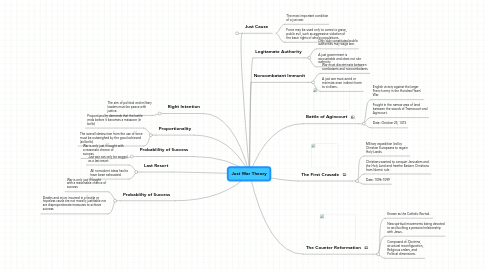Just War Theory
by kendall alexa

1. Just Cause
1.1. The most important condition of a just war.
1.2. Force may be used only to correct a grave, public evil, such as aggressive violation of the basic rights of whole populations.
2. Right Intention
2.1. The aim of political and military leaders must be peace with justice.
3. Proportionality
3.1. Proportionality demands that the battle ends before it becomes a massacre (in bello)
3.2. The overall destruction from the use of force must be outweighed by the good achieved (ad bello)
4. Probablilty of Success
4.1. War is only just if fought with a reasonable chance of success.
4.2. Deaths and injury incurred in a feutile or hopeless cause are not morally justifiable nor are disproportionate measures to achieve success.
5. Last Resort
5.1. Just war can only be waged as a last resort.
5.2. All nonviolent ideas had to have been exhausted.
6. Probablility of Success
6.1. War is only just if fought with a reasonale chance of success.
7. Legitamate Authority
7.1. Only duly constituted public authorities may wage war.
7.2. A just government is accountable and does not rule authroity.
8. Noncombatant Immunit
8.1. War must discriminate between combatants and noncombatants.
8.2. A just war must avoid or minimize even indirect harm to civilians.
9. The First Crusade
9.1. Military expedition led by Christian Europeans to regain Holy Lands.
9.2. Christians wanted to conquer Jerusalem and the Holy Land and freethe Eastern Christians from Islamic rule.
9.3. Date: 1096-1099
10. Battle of Agincourt
10.1. English victory against the larger French army in the Hundred Years' War.
10.2. Fought in the narrow area of land between the woods of Tramecourt and Agincourt.
10.3. Date: October 25, 1415
11. The Counter Reformation
11.1. Known as the Catholic Revival.
11.2. New spiritual movements being devoted to and builting a personal relationship with Jesus.
11.3. Composed of: Doctrine, structural reconfiguration, Religious orders, and Political dimensions.


